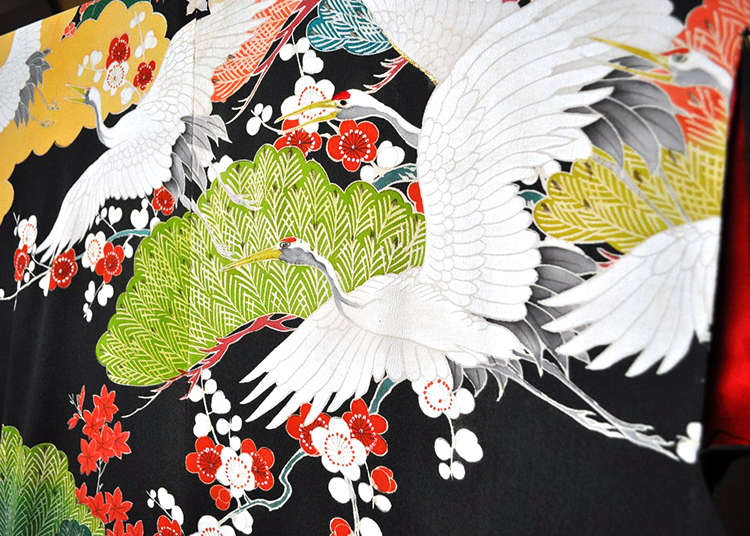
Kyoto’s Nishijin district is well-known for its textiles, many of which are turned into exquisite kimono. To better get to know these traditions, I visited the Orinasu-kan Museum of Hand-Weaving for a better look at these fabrics, and the master weavers at the Watabun workshop next door. I also visited Tondaya, a traditional Nishijin home in which visitors can try on the authentic kimono of the Tanaka family, kimono wholesalers and custodians of the home for thirteen generations.
For many, the image of Kyoto is captured in the soft rustle of silk at the ankles of a maiko, an apprentice geisha, as she hurries down a Gion sidestreet. In the Nishijin district, the most distinct Kyoto sound may not be the rustle of silk so much as rhythmic clacking of looms.
That sound is particularly crisp and clear here in the weaving room at Watabun weavers’ workshop.
Weaving on Kyoto's Historical Looms
“See here?” Mr. Murai, a master weaver here, points through the taut white strings of his loom. “That’s where the right side of the fabric comes out.” A strip of white and gold fabric glimmers up from below, its edge just visible.
Located in the northwestern part of central Kyoto, Nishijin is known as Kyoto’s textile district, and the source of many of its spectacular kimono and other woven silk products.
To demonstrate his technique, Mr. Murai sits down at his loom–or nearly, inside it: the wooden structure towers over our heads to the ceiling, sending down great loops of string like a suspension bridge. Deftly, he adds several rows of shimmering thread, the wooden slats of the machine clacking above him.
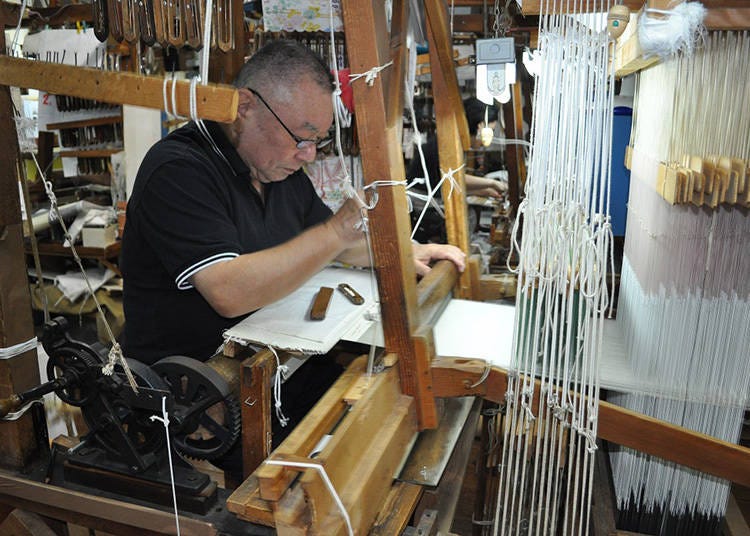
Mr. Murai and the other artisan weavers here are all extraordinary craftspeople. Many of the garments they create are replicas of antique garments with brilliant colors and exceptionally complex designs. Producing such works requires at least ten years of study (the craftsmen here each have twenty to fifty years of experience), but the weavers themselves are not the only ones involved in the production process: there are artisans for each task involved with the work here, from those at the rear of the workroom spinning dazzling thread, to the workers whose primary job is to loop the silk threads through the loom.
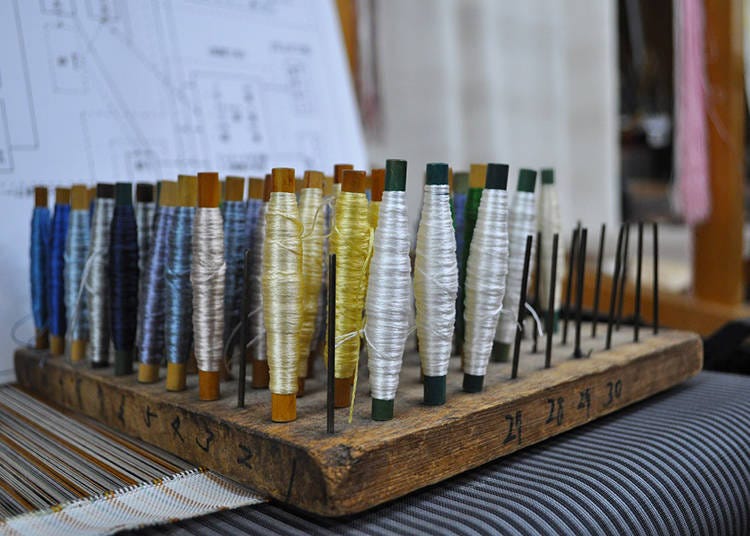
A selection of the artisans’ obi (kimono sashes) adorn a display room beside the workshop. Each piece can take anywhere from two weeks to one month to complete.
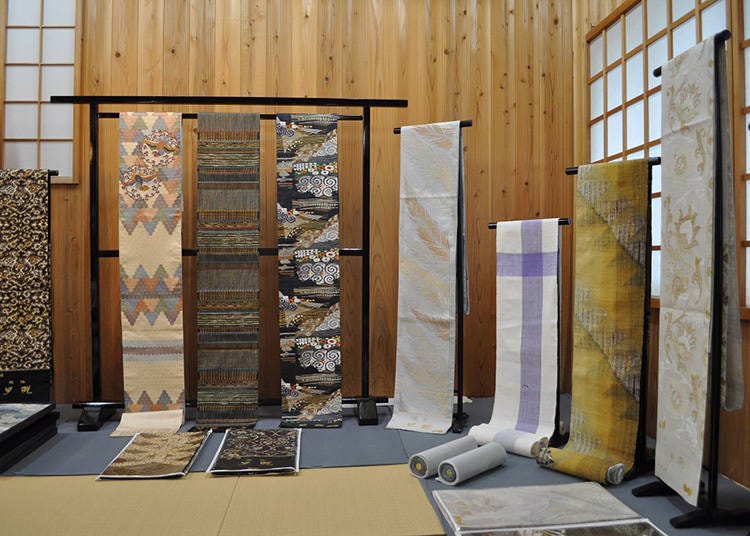
Exhibitions of the Textiles of Nishijin, and Beyond
The Orinasu-kan Museum of Hand-Weaving stands adjacent to the weavers’ workshop, a testament to the long history of textile craftsmanship in Nishijin. Built in 1936, the Orinasu-kan served as both a home and shop for the obi maker, Watabun himself, for many years. The Orinasu-kan building continues to serve as a museum, with various themed exhibitions, including traditional Noh theater costumes, extraordinary fabric bolts from across the country, and exquisite antique kimono.

Visitors to the Orinasu-kan can view these exhibitions, and even enjoy a cup of tea with a sweet in the building’s former living quarters while looking out on the home garden. Be sure to bring along socks for your visit to the museum, though–like many Japanese dwellings, you’ll need to remove your shoes before entering.
With a reservation (made ten days to two weeks in advance, for three or more people), visitors can also tour the Watabun weavers’ workshop next door, and try weaving in the Nishijin tradition for themselves on a simpler version of looms used by the artisans here. Just be sure to make an inquiry in advance: unlike the Orinasu-kan Museum, the adjoining Watabun weavers’ workshop operates as an independent business, and is not open for public viewing at all times.
Not far from the Orinasu-kan, and down another unassuming street is Tondaya, a traditional wooden machiya townhouse that dates to 1885. You’ll find no weavers here, but silks and Nishijin culture aplenty.
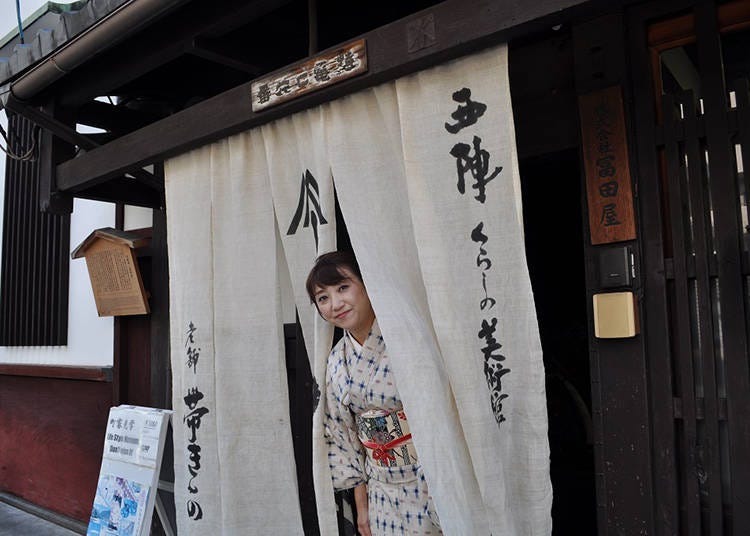
Living the Nishijin Way
Unusual by today’s standards, Tondaya has served as the base of operations for the Tanaka family of kimono wholesalers for generations. Currently, its custodian is the elegant Mineko Tanaka, an expert in the cultural graces of kimono dressing, tea ceremony, ikebana flower arrangement, and traditional life in Nishijin. Under her stewardship, Tondaya has been registered as a National Cultural Treasure, and operates today as a “Nishijin Lifestyle Museum.”

Wrapping a silk kimono from her family’s collection around a guest, Ms. Tanaka carries herself with both the elegance and serenity of her post, as well as the exactitude befitting her years as a teacher. “It’s easy, you see?” she says, “You can be dressed in a kimono in five minutes. Most importantly, everything here is the real thing. It’s authentic.” Looking around, it’s hard not to agree as she tuts at the idea of polyester pieces.
The glass in this main room looking out on the garden is 130 years old, as evidenced by its delicate warping, as though water were running over it. Were it to break, no craftsman would be able to return it to its original appearance.
Ms. Tanaka explains that she’d like Tondaya to be a place where people can gain a greater understanding of the traditional Japanese way of life. For the residents of such houses, she says, this way of life was centered around three points. She raises a finger for each: a hope or dream (negai), prayer (inori), and thankfulness (kansha). “Originally, living in a machiya meant to live side by side with gods of the home. This is really the root of the Japanese heart,” she explains. The home was a spiritual place.
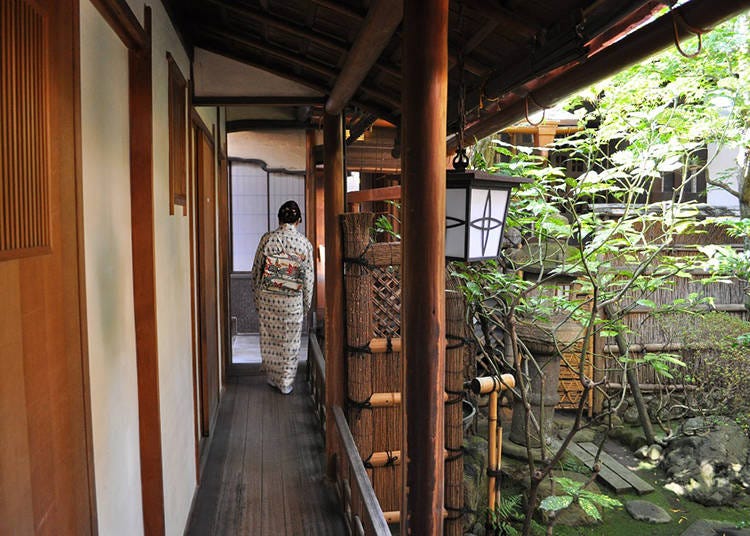
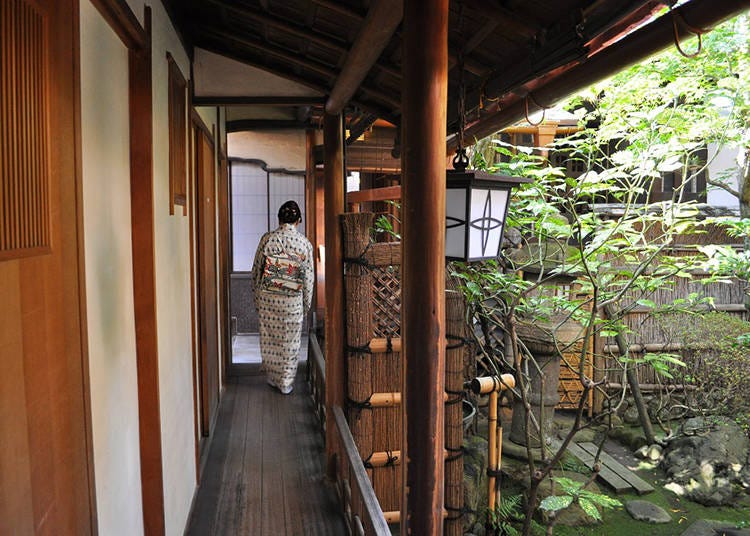
Hidden by its narrow exterior, Tondaya includes tea rooms, a Noh theater, three gardens, and three storerooms, each a wonder of historical secrets. In a guided tour of the machiya, guests can discover not only beautiful pieces like a great table inlaid with serpentine mother-of-pearl dragons, or a burst of gold powder that dimly lights the boards along the ceiling, but stories like that of the third storehouse, which has been left unopened for years. The reason? This room, too, is the domain of a god of the house.
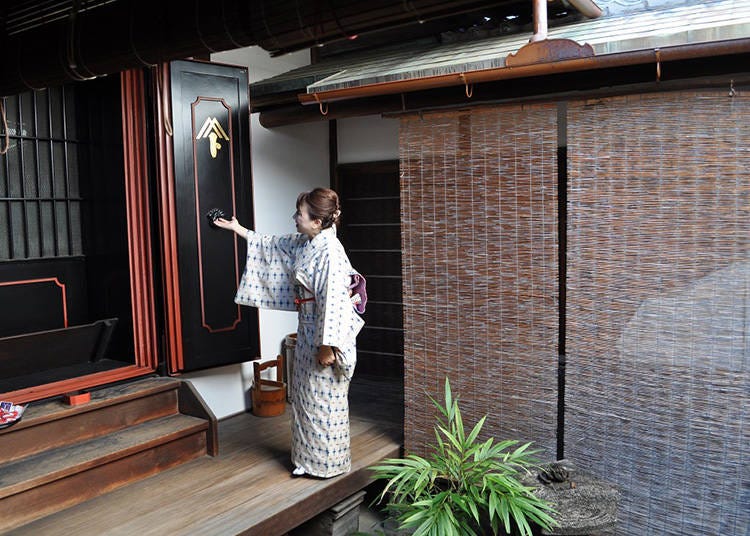
And in the rest of the house? Tondaya is kept lively with its own seasonal, traditional events throughout the year, and with lessons in tea ceremony, ikebana flower arrangement, kimono dressing, and other traditional arts. After thirteen generations in this Kyoto home, the hostesses here are well-equipped to share the Nishijin lifestyle with their guests.
See more about the locations in this article
Watabun
Orinasu-kan Museum of Hand-Weaving (Japanese only)
Nishijin Tondaya
By Abby Smith
Originally from California, I came to work in Japan in 2013. A lover of languages and shady spots along the Kamo Riverbank, I have been living in Kyoto since 2016. To this day, this thousand year-old city continues to surprise me--there's always something new to discover hiding in plain sight.
*Prices and options mentioned are subject to change.
*Unless stated otherwise, all prices include tax.
Popular Tours & Activitiess
Recommended places for you
-

Jukuseiniku-to Namamottsuarera Nikubaru Italian Nikutaria Sannomiya
Izakaya
Kobe, Sannomiya, Kitano
-
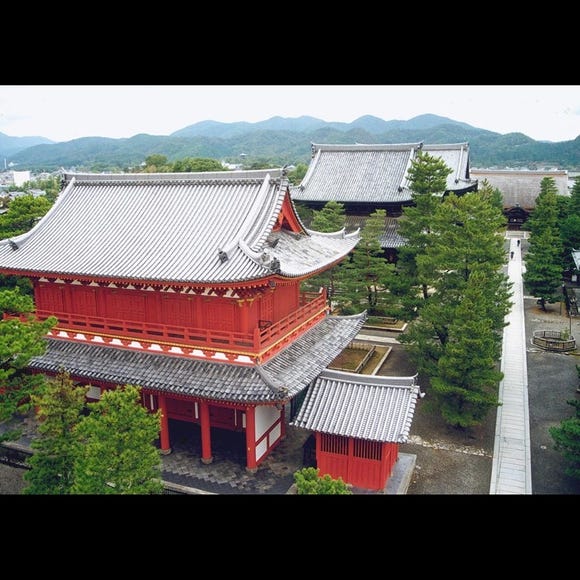
Myoshin-ji Temple
Temples
Arashiyama, Uzumasa
-
Goods

Yoshida Gennojo-Roho Kyoto Buddhist Altars
Gift Shops
Nijo Castle, Kyoto Imperial Palace
-

Kambei Sannomiyahonten
Yakiniku
Kobe, Sannomiya, Kitano
-

Kanzenkoshitsuyakinikutabehodai Gyugyu Paradise Sannomiya
Yakiniku
Kobe, Sannomiya, Kitano
-

ISHIDAYA Hanare
Yakiniku
Kobe, Sannomiya, Kitano
-

Everything You Need to Know About teamLab Biovortex Kyoto (2025 Insider Guide)
by: Wemmy Chau
-

Kyoto's Hidden Treasures Open This Winter! Enjoy Exclusive Access to 15 Rare Cultural Sites (Jan-Mar 2026)
by: Guest Contributor
-
Ad

Recharge and Relax with a Healing Getaway at Kamenoi Hotel Toba
-
Ad

Experiencing Manga as Culture, Not Just Reading It: Expo 2025 with Rumiko Takahashi
-
Ad

Café Bahnhof in Osaka: The home-roasted coffee that captivated G20 leaders!
-
Ad

Discover Timeless Beauty: Kimono-en, a Web Magazine Exploring the Spirit of Kimono
Inspiration for Accommodations
-

Spacious Family Hotel in Namba: 20 Comfortable Stays for Family Fun
-

Charming Hotels to Enjoy the Spectacular Views of Arashiyama's Autumn Leaves from Your Room
-

Experience Stunning Views of Osaka Castle from Private Spaces: Top Hotels Near Osaka Castle
-

Recommended by Visitors! Arashiyama's Best-Rated Hotels
-

Family-Friendly Universal Studios Japan Hotel with Excellent Access
-

Enjoy a Comfortable Stay in Osaka! 10 Hotels with Convenient Airport Shuttle Services
-

Top 10 Recommended Hotels Near Namba Station with Great Access
-

Enjoy Night Views from Your Room! Recommended Hotels in Namba Area
-

10 Watch Shops in Osaka and Kyoto - Tax-Free Shopping and Irresistible Discounts
-

Inside Kobe Tower: Fun Things to Do at the Symbol of Kobe
-

6 Surprisingly Cheap Things in Japan
-

Mystical Beauty, Dance & Swordplay: Why Tourists Are Flocking to REVUE Japan!
by: WESTPLAN
-

Ippudo Osaka and More: These 5 Ramen Restaurants in Osaka Are Going Viral
by: WESTPLAN
-

5 Must-Visit Nara Temples and Shrines: Discover the Timeless Beauty of Japan's Ancient Capital
by: WESTPLAN
- #best gourmet Osaka
- #things to do Osaka
- #what to do in kyoto
- #what to bring to japan
- #best gourmet Kyoto
- #new years in Osaka
- #what to buy in nanba
- #Visiting Osaka
- #onsen tattoo friendly arima
- #daiso
- #Visiting Kyoto
- #best japanese soft drinks
- #japanese fashion culture
- #japanese convenience store snacks
- #japanese nail trends













